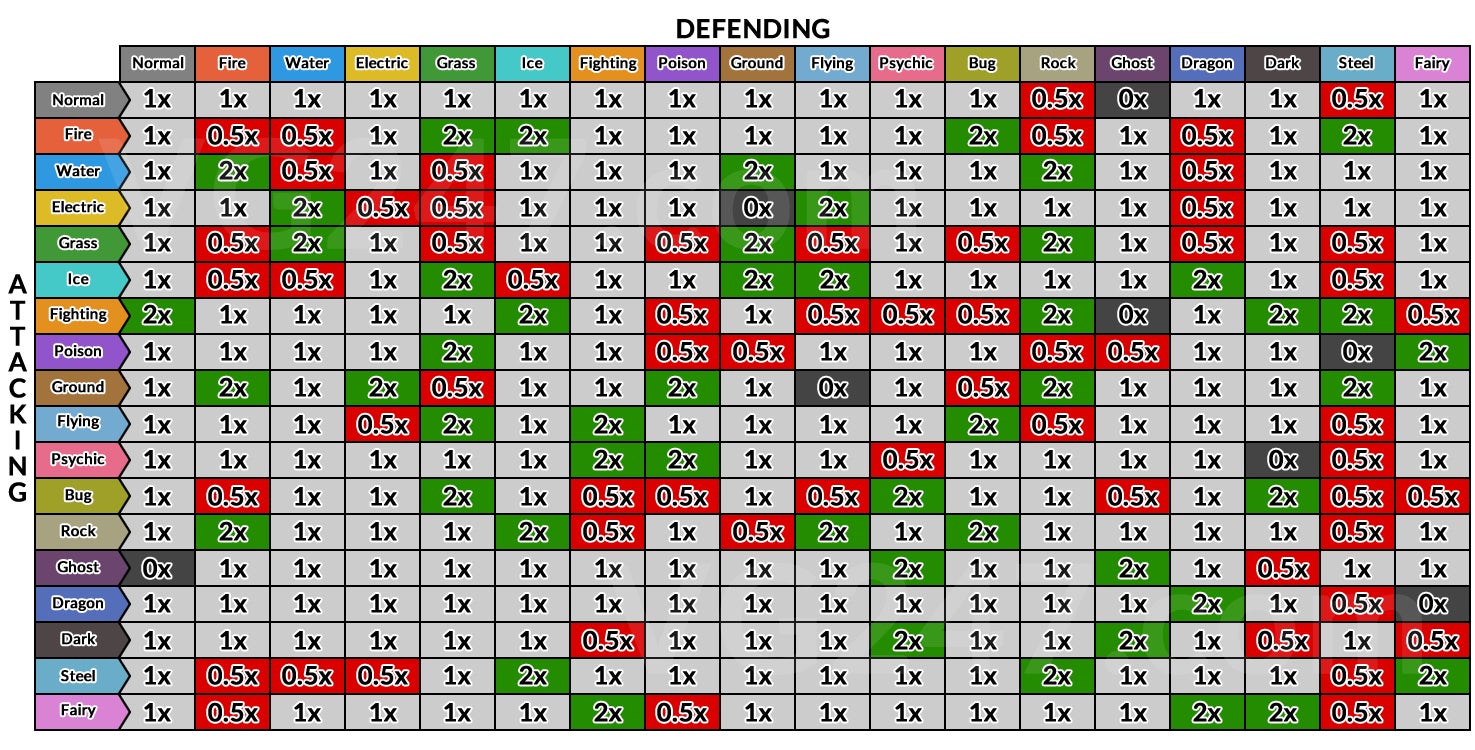Understanding Pokemon type strengths, weaknesses and resistances are absolutely essential to triumphing in battle, especially when you reach the later stages of the game and face some really challenging, high-level battles.
Understanding Pokemon Type Strengths, Weaknesses, and STAB
Here’s how Pokemon’s type system works. Every single Pokemon has either one or two ‘types’ assigned to it. These are pretty obvious - so Machop, the karate-chopping Pokemon, is Fighting type. Gastly, the spectre, is a Ghost type. Magikarp, a flopping fish, is of course a water-type. Some Pokemon can hold dual types - so for instance the butterfly-like Pokemon Beautifly is a dual Bug and Flying type. Similarly, every single Pokemon move in the game is tagged with an associated element and type. That means when you’re learning and changing a Pokemon’s moves, you’ll want to consider type coverage, thinking about what sort of damage they can do. In battle, this manifests itself as strengths and weaknesses. For instance, a Fire-type Pokemon can burn Grass-type Pokemon to the ground and melt Ice-type Pokemon likewise - meaning they do more damage to those types. But Fire is vulnerable to Water-type Pokemon, which can douse those flames. The same is true of Resistance - so in return, Fire really isn’t very effective against Water. Some Pokemon are even entirely invulnerable to moves of certain types. There’s wrinkles to this, of course. There’s three in particular we should touch on:
About STAB, the Same Attack Type Bonus
The STAB bonus is a 1.5x bonus multiplyer on the move’s effectiveness - which stacks with things like type weaknesses, which can in turn lead to truly devastating one-hit KO moves - if you play your battle right.
What happens with two-type Pokemon?
If a Pokemon has a dual type, it’ll have to consider the strengths and weaknesses for both of its types. Having two types means they’ll have more strengths, but also more gaps in their defenses. Type weaknesses and strengths stack, which means that you can cause as much as quadruple damage, or reduce incoming damage to just a quarter of the standard amount. If a Pokemon uses a move that both of its opponents types are weak too, it’ll do double damage twice for 4x damage. If that move were one both types are resistant to, it’d get halved twice, down to 0.25x.
How are Status Attacks effected by Strength and Weakness?
We love a quesiton we can give a short answer to, and that’s this: they often aren’t. The type chart tends to deal with moves that dish out damage, which many status attacks do not. So, for instance, an electric-type move that might Paralyse the opponent is no more effective on a water-type Pokemon than any other, despite electric-type moves being super effective against water-type Pokemon. The one exception to this is immunities; they are still in play even with status effects; so an electric-immune Pokemon can’t be paralysed with an electric-type move, and so on. With that explained, here’s a type chart and explainer of how the Pokemon types work in Legends: Arceus - which has changed up a lot of gameplay systems but left this one relatively untouched.
Pokemon Legends: Arceus Type Chart
As has been the case in the series for a while now, there are 18 different Pokemon types overall. That’s Normal, Fire, Water, Electric, Grass, Ice, Fighting, Poison, Ground, Flying, Psychic, Bug, Rock, Ghost, Dragon, Dark, Steel, and Fairy. Counting them all, and dual-typing, that’s 324 possible type configurations - quite a lot. Our chart explains these types - but here’s how it works, to be clear:
The Y Axis (vertical) lists the Attacker. So pick the type of Pokemon move you plan to use, and then work your way across, to the right, to see the damage you’ll do. The X Axis (horizontal) lists the Defender. If you want to know what moves will resist what you’re facing off against, pick your Pokemon’s type(s) from the top bar, then trace down to the types you’re being attacked by.
And here’s how the move effectiveness works:
Normal effectiveness (1x): deal the standard amount of damage. Super-effective (2x): deal out twice the damage. Not very effective (0.5x): does half the normal damage. Not effective moves (0x): does no damage.
If you would prefer a text-based chart, check out the version below. The same rules apply, using the same terminology as above:
When Attacking: Super Effective moves do double damage, Not very Effective moves do half damage When Defending: Resist moves do less damage, and Weak Vs. moves do Double Damage
If you’re after more Pokemon Legends: Arceus guides, such as how to learn moves, how to changes moves, how to unlock more Base Camps, which is the best starter Pokemon, how to evolve or how to upgrade your Satchel space, click on the links to learn everything you need to know.
